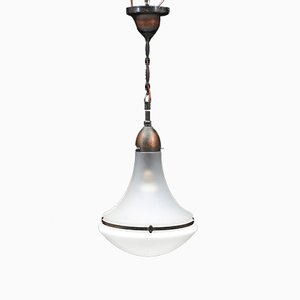
Architect, designer, and artist Peter Behrens (1868-1940) was one of the 20th century's most influential German designers, and is known as the father of modern industrial design. He was also a founding member of the Munich Secession and co-founder of the Deutscher Werkbund (German Association of Craftsmen), which paved the way for the Bauhaus movement.
Born in 1868 in Hamburg, Behrens studied painting in his hometown, as well as in Düsseldorf and Karlsruhe. In 1890, he moved to Munich where he began his career as a painter, illustrator, and bookbinder, before moving again in 1903 to teach at the School of Applied Arts in Düsseldorf. In 1899, Behrens was offered the opportunity by the Grand-duke Ernst Ludwig of Hesse to construct a house in the newly developed Darmstadt Artists' Colony. Behren moved away from the decorative ornamentation of Jugendstil (or Art Nouveau), in favor of a sober and unadorned aesthetic.
In 1907, Behrens, along with other artists, designers, and companies, founded the Deutscher Werkbund, an organization which incorporated the principles of the English Arts and Crafts movement with decidedly new, modernist ideas that aimed to improve the design of everyday objects. Behrens’ commitment to these objectives and the viability of the organization’s ideals can be seen most clearly in his 1909 design for the AEG Turbine Factory in Berlin. Despite Behrens’ complete lack of engineering or architectural training, the factory is generally considered to be one of the earliest and most influential examples of modernist architecture, and is still in use over 100 years later.
Behren’s relationship with AEG (Allgemeine Elektricitäts-Gesellschaft, or General Electric Company) was pioneering and modern. Never employed directly by AEG, Behrens worked as Artistic Consultant, creating an entire corporate identity and branding for the industrial giant. Behrens first assignment was re-designing factory lamps, which he streamlined by adjusting their sculptural properties and proportions. Due to the lamps weighty success, Behrens continued to design other pieces for AEG which included, clocks, coffee machines, kettles, ventilators, and watches, as well as typefaces, advertisements, and logos. His design ethos contextualized modernism within the rapidly changing age of industrialization.
From 1907 to 1912, Brehen’s studio was a magnet for some of the most important modernist architects and designers of the 20th century. Notably, Walter Gropius (1883-1969), Ludwig Mies van der Rohe (1886-1969), and Le Corbusier (1887-1965) all trained under or worked for Behrens at the beginning of their careers. Behrens taught at the Academy of Fine Arts in Vienna from 1922 until 1927, and held the position of head of the Department of Architecture at the Prussian Academy of Arts in Berlin, where he continued to teach for many years.
In 1926, toy-manufacturer Wenman Joseph Bassett-Lowke commissioned Behrens to replace the 19th-century home he had had renovated by Charles Rennie Mackintosh. Generally considered the first example of modernist residential architecture in the UK, Behrens’ New Ways house was designed 19 years after the Deutscher Werkbund was organized to compete against British design.
Over the course of his career Behrens designed many iconic buildings including the Mannesmann-Werke in Düsseldorf (1911–12), the grandiose German Embassy (1911-913) in the then-Russian capital Saint Petersburg, and the New Synagogue (1928-31) in Žilina, Slovakia, to name but a few. He also designed the iconic typography of the Dem Deutschen Volke inscription on Berlin’s Reichstag building.
Behrens died in Berlin in 1940 at the age of 71. The faculties for architecture and interior design at the University of Applied Sciences (Fachhochschule) in Düsseldorf has been named in his honor.


